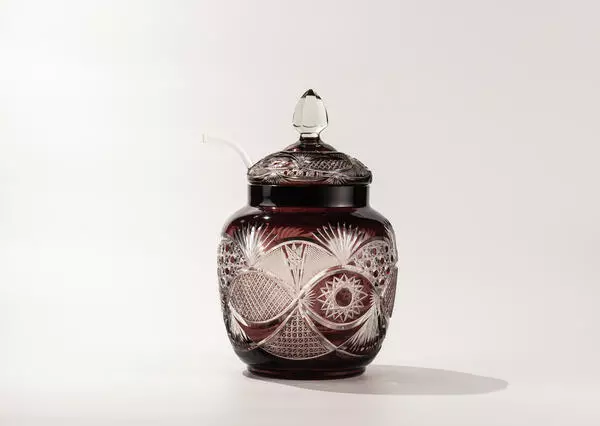The “Tulip” decorative vase was created by Yevgraf Shuvalov, the People’s Artist of the Russian Soviet Federative Socialist Republic who worked at the Dyatkovo Crystal Factory for over 40 years. In 1983, he was awarded the RSFSR Ilya Repin State Prize. Yevgraf Shuvalov was one of the founders of the Bryansk Branch of the Russian Union of Artists. His works are characterized by a deep understanding of the material, excellent skill, and respect for the traditions of Russian glass art. His elegant sets and services, original compositions, and monumental vases dedicated to memorable dates were presented at not only Soviet but also international exhibitions.
The “Tulip” vase consists of five parts. They are inserted one into another according to the traditional mounting method. This vase resembles a flower in full bloom. The transparent components are made of crystal. This is the type of glass that contains 6 to 36% lead oxide. Lead gives the glass its distinctive gloss finish, ringing sound, and transparency. This type of glass was first produced in 1676 by an Englishman George Ravenscroft (1632–1683). Crystal gained widespread use in the late 18th century.
According to the standards of the Dyatkovo Crystal Factory, crystal contains 24% lead oxide. The crystal parts of the vase are decorated using the technique of deep or diamond-shaped cutting. This is a time-consuming and labor-intensive process that requires special equipment. Crystal is cut using grinding discs rotating at a high speed. This technique was first used for processing thick-walled products in 18th-century England. The most popular type of facet is cut using a disc at a 45º angle and has V-shaped cuts, which cross to form certain images. Initially, the image looks dull and dim. The distinctive gloss is achieved by polishing the crystal facets with a mixture of sulfuric and hydrofluoric acid.
The colored part of the vase was created by coloring the glass with manganese compounds. Such glass can take on various shades from purple to amethyst. Manganese is added to the glass batch in the form of pyrolusite, a mineral that contains almost 90% manganese oxide.
The “Tulip” vase consists of five parts. They are inserted one into another according to the traditional mounting method. This vase resembles a flower in full bloom. The transparent components are made of crystal. This is the type of glass that contains 6 to 36% lead oxide. Lead gives the glass its distinctive gloss finish, ringing sound, and transparency. This type of glass was first produced in 1676 by an Englishman George Ravenscroft (1632–1683). Crystal gained widespread use in the late 18th century.
According to the standards of the Dyatkovo Crystal Factory, crystal contains 24% lead oxide. The crystal parts of the vase are decorated using the technique of deep or diamond-shaped cutting. This is a time-consuming and labor-intensive process that requires special equipment. Crystal is cut using grinding discs rotating at a high speed. This technique was first used for processing thick-walled products in 18th-century England. The most popular type of facet is cut using a disc at a 45º angle and has V-shaped cuts, which cross to form certain images. Initially, the image looks dull and dim. The distinctive gloss is achieved by polishing the crystal facets with a mixture of sulfuric and hydrofluoric acid.
The colored part of the vase was created by coloring the glass with manganese compounds. Such glass can take on various shades from purple to amethyst. Manganese is added to the glass batch in the form of pyrolusite, a mineral that contains almost 90% manganese oxide.






